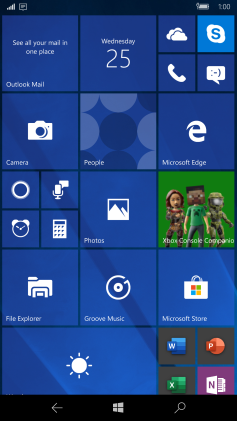 Screenshot of Windows 10 Mobile home screen | |
| Developer | Microsoft Mobile |
|---|---|
| OS family | Windows 10 |
| Working state | No longer supported |
| Released to manufacturing | November 20, 2015[1] |
| General availability | March 17, 2016 |
| Final release | 10.0.15254.603 (KB4535289)[2] / January 14, 2020 |
| Update method | Windows Update[3] |
| Package manager | XAP, APPX |
| Platforms | ARM 32-bit,[4] ARM 64-bit |
| Kernel type | Hybrid (Windows NT) |
| Preceded by | Windows Phone 8.1 (2014) Windows RT (2012) |
| Succeeded by | Microsoft Launcher via Android in Surface Duo (2020) |
| Support status | |
| Version 1511 November Update: Unsupported as of January 9, 2018[5]
Version 1607 Anniversary Update: Unsupported as of October 9, 2018[6] Version 1703 Creators Update: Unsupported as of June 11, 2019[7] Version 1709 Fall Creators Update: Mainstream support ended on December 10, 2019 Extended support ended on January 14, 2020[8][9] | |
| Part of a series of articles on |
| Windows 10 |
|---|
| Siblings |
| Related |
Windows 10 Mobile is a discontinued mobile operating system developed by Microsoft Mobile. First released in 2015, it is the successor to Windows Phone 8.1, but was marketed by Microsoft as being an edition of its PC operating system Windows 10.[10][11]
Windows 10 Mobile aimed to provide greater consistency with its counterpart for PCs, including more extensive synchronization of content, Universal Windows Platform apps, as well as the capability, on supported hardware, to connect devices to an external display and use a desktop interface with mouse and keyboard input support (reminiscent of Windows on PCs). Microsoft built tools for developers to port iOS Objective-C apps with minimal modifications. Windows Phone 8.1 smartphones are eligible for upgrade to Windows 10 Mobile, pursuant to manufacturer and carrier support.[12] Some features vary depending on hardware compatibility.[13]
Windows 10 Mobile was designed for use on smartphones and tablets running on 32-bit ARM processor architectures.[4] Microsoft also intended for the platform to be used on ARM tablets with screens 9 inches or smaller in size, but such devices were rarely commercially released. Windows 10 Mobile entered public beta for selected Lumia smartphones on February 12, 2015.[14] The first Lumia smartphones powered by Windows 10 Mobile were released on November 20, 2015, while eligible Windows Phone devices began receiving updates to Windows 10 Mobile on March 17, 2016, pursuant to manufacturer and carrier support.
The platform never achieved any significant degree of popularity or market share in comparison to Android or iOS. By 2017, Microsoft had already begun to downplay Windows 10 Mobile, having discontinued active development (beyond maintenance releases) due to a lack of user and developer interest in the platform, and focused on serving incumbent mobile operating systems as part of its software and services strategy. Support for Windows 10 Mobile ended on January 14, 2020. As of November 2021[update], Windows 10 Mobile had approximately a 0.01% share of the mobile operating system market.[15]
- ^ Dolcourt, Jessica (October 6, 2015). "Microsoft Lumia 950 coming in November with Windows 10, 5.2-inch screen, starts at $549 (hands-on)". CNET. CBS Interactive.
- ^ "January 14, 2020—KB4535289 Update for Windows 10 Mobile (OS Build 15254.603)". Microsoft. Retrieved January 14, 2020.
- ^ Cite error: The named reference
build14322was invoked but never defined (see the help page). - ^ a b Cite error: The named reference
Min_hard_reqwas invoked but never defined (see the help page). - ^ "Windows 10 Mobile, released in November 2015".
- ^ "Windows 10 Mobile, released in August 2016".
- ^ "Windows 10 Mobile, released in April 2017".
- ^ Woods, Rich (January 14, 2020). "Windows 10 Mobile is dead ... again". Neowin. Retrieved January 14, 2020.
- ^ "Windows 10 Mobile, released in October 2017".
- ^ Cite error: The named reference
Windows10MobileNamewas invoked but never defined (see the help page). - ^ "Microsoft will unify Windows, Windows Phone, and Xbox into 'one converged operating system'". ExtremeTech. Ziff Davis. Retrieved October 31, 2015.
- ^ Bright, Peter (January 24, 2015). "Every Windows Phone 8 phone will get Windows 10, except the ones that won't". Ars Technica. Condé Nast.
- ^ "Yes, Windows 10 is Coming to Low-End Windows Phones". thurrot.com. Self-published. February 9, 2015. Retrieved February 11, 2015.
- ^ "Windows 10 won't launch on phones this summer". The Verge. Vox Media. April 30, 2015. Retrieved July 2, 2015.
- ^ "Mobile Operating System Market Share Worldwide | StatCounter Global Stats". StatCounter. Retrieved June 22, 2020.